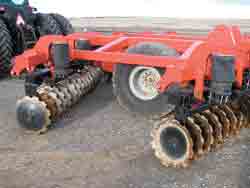
When Tone Kubik built the disk he calls "Rockzilla", he decided to build it to heavy-duty semi-truck specifications using off-the-shelf components. That's how he got the idea to use truck air bags for suspension and to control gang flotation. Air bags at the hitch and front and rear rows of gangs give Kubik three-way leveling and more.
"The air adjusting hitch takes the shock off the tractor," says Kubik. "I can pull it across a rocky field and not even feel a thing, but when I look back, the gangs are working all the time."
He sets the depth and then adjusts the air pressure front to back. At 1,000 lbs. per ft., penetration is no problem, and the high flotation truck tires keep the disk from sinking into the ground or leaving tire tracks.
"I can turn as sharp as I want without worrying, and the frame is strong enough to handle a heavy packer on tight turns," says Kubik.
The three 6 by 8-in., 3/8-in. wall, structural steel frame beams serve as the main air tank and two auxiliary tanks. The center beam has the air capacity of a 120-gal. tank. If needed, air can be bled from the two side beams. Because it's a closed system, one fill per season can be enough.
"I've put 100 lbs. pressure in the tanks, run the disk for five weeks and it was still at 90 lbs. pressure," says Kubik.
To maximize gang independence and ability to flex over rocks, Kubik designed the gangs to carry only five, 24-in. disk blades each. The gangs ride on standard case bearings, which are easily changed out if needed.
The disk is raised and lowered over the 20,000-lb. axle with oversized 8-in. cylinders with 2 1/2-in. shafts.
"I designed the disk for high clearance," says Kubik. "When it's raised up, I can walk around and grease bearings without bending over, and I'm 6 ft. 2 in."
Another feature of the design is ease of transport. Unlike other disks that are relatively balanced front to back when lifted, Kubik's disk has 30 percent more hitch weight on the front. This maintains a constant load on the hitch and, combined with the flotation truck tires, ensures smoother trailing."I can pull it behind a semi-tractor or behind a field tractor at 25 to 30 mph, and I don't even know it's there," he says.
Kubik is talking to several manufacturers about marketing his design. He expects the easily available components should help keep the price competitive with other disks.Regardless of whether his one-of-a-kind disk makes it to market, he has what he wanted when he started planning it. He's confident the heavy-duty construction and air bag system will last.
"I wanted a disk that I could just pull out of the barn in the spring without spending time welding and repairing," he says. "I wanted something that would still be around for my grandkids."
